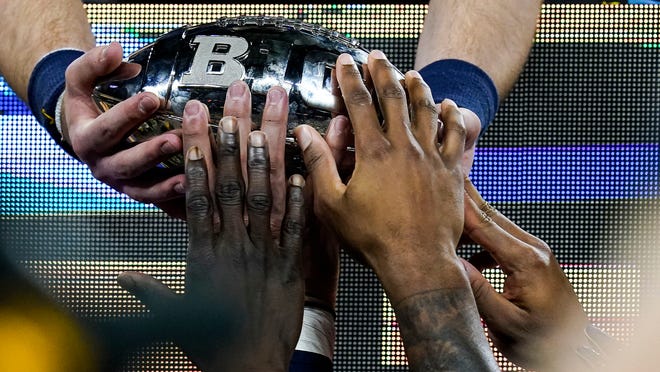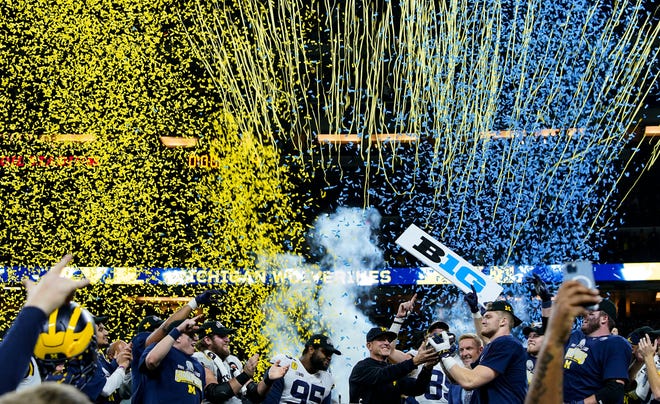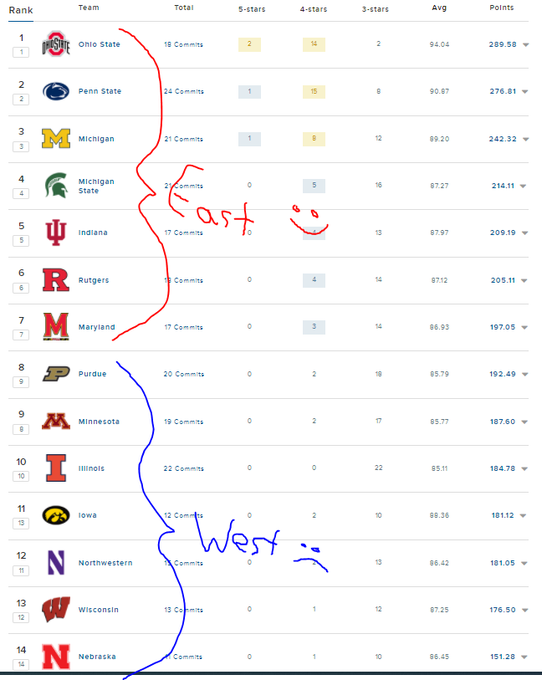Signing day latest example Big Ten's East-West divisions are too lopsided, need a rethink
Since realignment, the East has won all eight Big Ten championship games. The average margin of victory in that time: 20 points.
Zach OstermanIndianapolis Star
View Comments

Years ago, on the eve of the Big Ten’s move to an east-west divisional alignment, an IU coach told me the Hoosiers were excited at the prospect.
This ran against the widely held belief among his fans, that the move would further cement the program’s ceiling, forcing Indiana to play Ohio State, Penn State, Michigan and Michigan State every season while in-state rival Purdue got off relatively easier. Going into the East, fans said then, was a hammer blow to IU’s burgeoning football ambitions.
Said coach disagreed. The East, they said, was where the real action in the Big Ten would be. Playing in the East would allow IU to offer players a chance to face the conference’s best teams, in its biggest, most impressive venues, year after year. There was little more than a potentially softer schedule to recommend the West.
The intimation was clear: The East was the big ticket. Eight years later, little has happened to dispel that notion, creating an imbalance the conference needs to address — even if it doesn’t want to.
That divide felt enormously pronounced on Wednesday, when the dust settled to reveal the Big Ten’s teamwide recruiting rankings split along divisional lines. The entire top half of the conference’s rankings belonged to the East, the bottom half to the West.
Those numbers are skewed somewhat by smaller classes at Wisconsin, Iowa and Nebraska. Recruiting rankings are based partly on quantity, and the free COVID year will lead some programs to take smaller classes for the time being, then hit the portal on the back end to make up the difference. Nevertheless, it’s just the most extreme example of a consistent trend.
In the eight full recruiting cycles since the Big Ten’s first post-realignment season, 2014, the East has never accounted for fewer than four of the conference’s top seven recruiting classes. Five of those eight years (including this one), that number has been five or better. One of the years the East only had four of the top seven, it still had five of the top eight.
Consistently, the same schools have showed up at the top of those rankings — Ohio State, Penn State, Michigan, etc. Results on the field have followed results in recruiting. Since realignment, the East has won all eight Big Ten championship games. The average margin of victory in that time: 20 points. Three times in those eight years, you could make a credible case the West champion would’ve been a playoff contender had it won the game.
Like it or not, that is the chief currency in college football right now, which means it is the most valuable currency in college sports. Playoff participation is the surest way to pull up a seat at the big boys’ table, and from a Big Ten perspective, the East dominates it. Since the Playoff’s inception in 2014, a team from the East has finished in the top 12 — not an assurance but a good baseline for potential participation in New Year’s Six bowls — of the final rankings 19 times. Nineteen. For the West, that number is four.

The result is a conference whose ambitions have become as lopsided as its divisions. Too often, the Big Ten’s best teams are forced to spend the season beating up on one another while the conference waits and hopes one rises above the fray with a legitimate playoff resume. It’s an unnecessary risk. The SEC, the conference the Big Ten would like to consider its closest (perhaps only) peer, has never missed a playoff. Twice, including this year, it has landed multiple teams in the field. The Big Ten can say neither of those things, and it’s worth noting, via the admittedly small sample size of eight years, that the two times the SEC put multiple teams in the national semifinals, they came from opposite divisions.
Not that this topic hasn’t come up. Repeatedly, in conference-wide media settings first with Jim Delany and more recently with Kevin Warren, Delany’s successor as commissioner, the question of reexamining divisions has been raised. And the reply is always been some version of the same answer: The conference is good with what it has. Which begs a more fundamental question: Should it be?
The East-West alignment is easy. It’s geographically clean, and only requires the Big Ten to protect one rivalry (IU-Purdue), making scheduling easier. But all of us in the media, including yours truly, who mocked the conceit of the “Legends” and “Leaders” divisions ignored that the distribution of power was much more even: Iowa, Michigan and Michigan State on one side, Wisconsin, Ohio State and Penn State on the other.

Now, the conference is top heavy, and it’s not putting its best foot forward as a result. What else might work?
Warren has suggested expansion is not on the Big Ten’s list of priorities at present, but if the conference ever got to 16 teams, a pod-like alignment would be interesting. Four groups of four, giving each Big Ten team three dedicated opponents to preserve rivalries and break up power monopolies. If the league stayed with a nine-game schedule, it could split the remaining 20 games against non-pod opponents over three seasons home and away, with one home and one road game lopped off the end to make the numbers work. It would be even cleaner if the conference went back to eight games: three dedicated opponents every year, and then the other 10, home and away, played across a four-year cycle, with five non-pod conference games each year.
Assuming the Big Ten stays at 14, North-South might be a better split, perhaps trading the Michigan schools to the North for Purdue and Illinois to the South. That would put Ohio State and Penn State on one side, Michigan, Michigan State, Iowa and Wisconsin on the other. It wouldn’t be perfect, and there would still need to be some built-in rivalry protection, but it would at least redistribute the conference’s most-powerful brands to some degree. This is, of course, entirely speculation. The conference has shown little appetite for a second post-expansion realignment. It is increasingly clear the Big Ten is comfortable with its present condition, regardless of its flaws.


